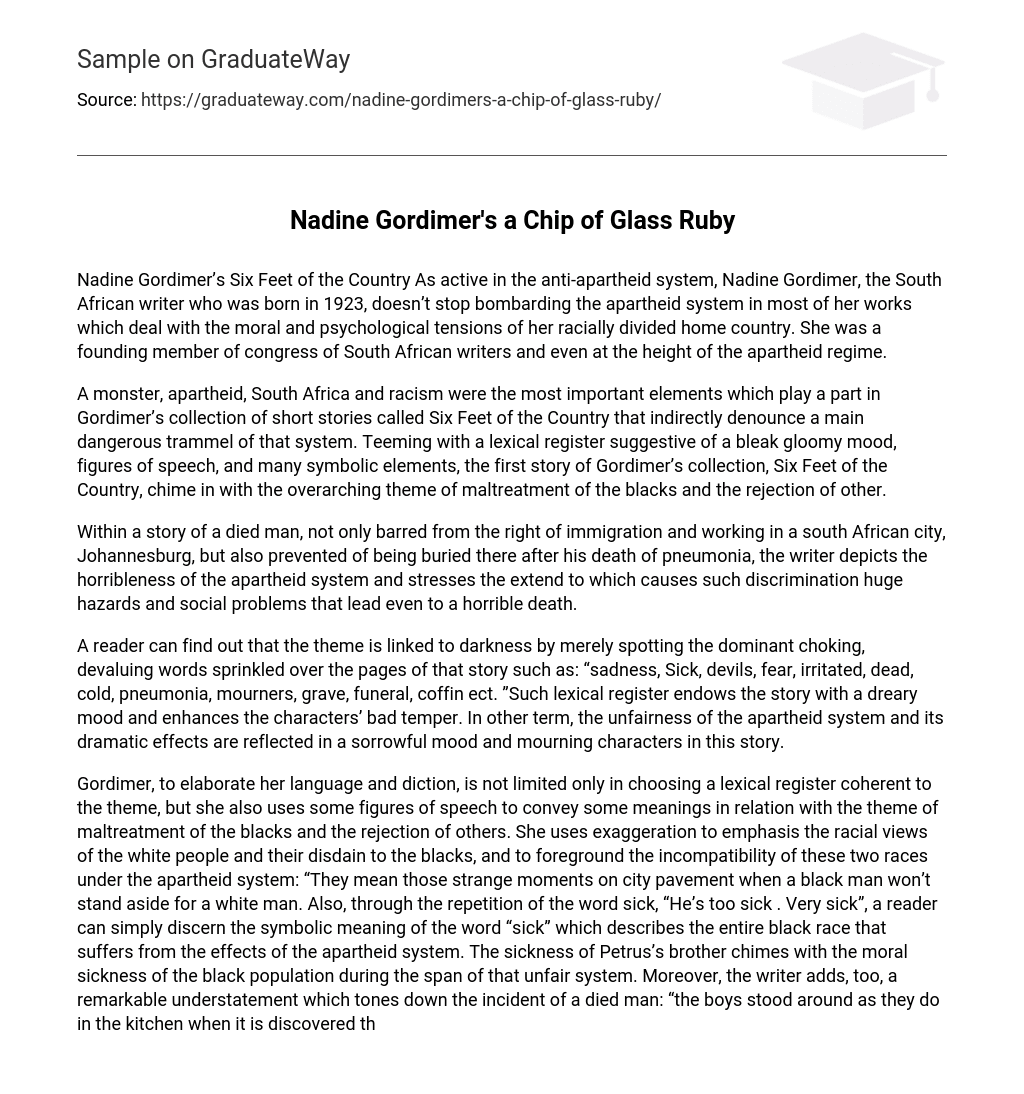Nadine Gordimer’s Six Feet of the Country As active in the anti-apartheid system, Nadine Gordimer, the South African writer who was born in 1923, doesn’t stop bombarding the apartheid system in most of her works which deal with the moral and psychological tensions of her racially divided home country. She was a founding member of congress of South African writers and even at the height of the apartheid regime.
A monster, apartheid, South Africa and racism were the most important elements which play a part in Gordimer’s collection of short stories called Six Feet of the Country that indirectly denounce a main dangerous trammel of that system. Teeming with a lexical register suggestive of a bleak gloomy mood, figures of speech, and many symbolic elements, the first story of Gordimer’s collection, Six Feet of the Country, chime in with the overarching theme of maltreatment of the blacks and the rejection of other.
Within a story of a died man, not only barred from the right of immigration and working in a south African city, Johannesburg, but also prevented of being buried there after his death of pneumonia, the writer depicts the horribleness of the apartheid system and stresses the extend to which causes such discrimination huge hazards and social problems that lead even to a horrible death.
A reader can find out that the theme is linked to darkness by merely spotting the dominant choking, devaluing words sprinkled over the pages of that story such as: “sadness, Sick, devils, fear, irritated, dead, cold, pneumonia, mourners, grave, funeral, coffin ect. ”Such lexical register endows the story with a dreary mood and enhances the characters’ bad temper. In other term, the unfairness of the apartheid system and its dramatic effects are reflected in a sorrowful mood and mourning characters in this story.
Gordimer, to elaborate her language and diction, is not limited only in choosing a lexical register coherent to the theme, but she also uses some figures of speech to convey some meanings in relation with the theme of maltreatment of the blacks and the rejection of others. She uses exaggeration to emphasis the racial views of the white people and their disdain to the blacks, and to foreground the incompatibility of these two races under the apartheid system: “They mean those strange moments on city pavement when a black man won’t stand aside for a white man. Also, through the repetition of the word sick, “He’s too sick . Very sick”, a reader can simply discern the symbolic meaning of the word “sick” which describes the entire black race that suffers from the effects of the apartheid system. The sickness of Petrus’s brother chimes with the moral sickness of the black population during the span of that unfair system. Moreover, the writer adds, too, a remarkable understatement which tones down the incident of a died man: “the boys stood around as they do in the kitchen when it is discovered that someone has broken a dish. Through this figure of speech, the writer wants to show that the black people were often exposed to death under the apartheid system, so that death became as a normal thing for them. Nadine Gordimer is not only apt in showing the reader about the harshness of the apartheid system through the diction, but she is also adept at choosing symbolic settings, situations, and imageries to highlight the main theme. The place, where both the white speaker and his wife live, is imbued with beauty and brilliance, as the writer depicts it; however, Petrus’s black family’s home is a hut.
This implicit symbolic contrast reflects a manifestation of the rejection of the other, the blacks. Another symbolic element is the speaker’s rejection to his wife: “I know through the way she never looks at me when she talks to me at breakfast next day that she is hurt and humiliated at my not wanting her. ”That kind of relationship cuts the right at the core of the apartheid system repression of the black people. Interestingly enough, the image of the faint light plays an important, symbolic role in drawing the blacks’ situation under that political system, for they were living hidden in darkness.
The light of the torch and the light of the candle are as like as a faint light squeezing from a little gap in a dark place in which the blacks are hidden from the political system. More to the point, an avid reader can notice the repetition of the word “kitchen” throughout the story. A kitchen is place that links with spiritual nourishment and caring for others. Characters’ emplacements revolve around the kitchen as if they are looking for help, care and warmth.
All these symbols help enhance a reader’s sympathy with the blacks and convey the main theme. Eventually, Gordimer’s creation is obvious through the usage of choking words creative of a bleak mood coupled with bad characters’ temper, witty figures of speech, and clever symbolic elements. These all come to elaborate the theme of the rejection of other and enhance its horribleness and chock born from the apartheid system, the source of the social problems from which the characters suffer.





